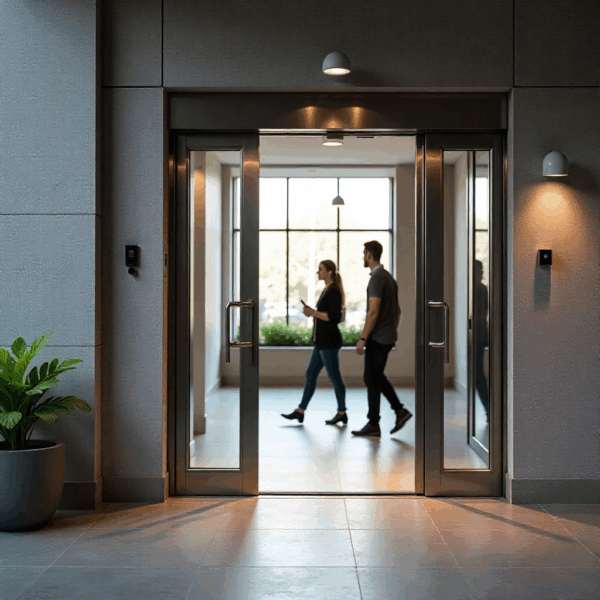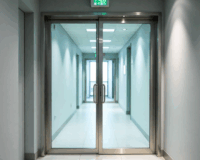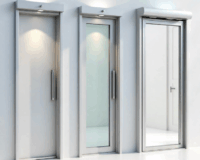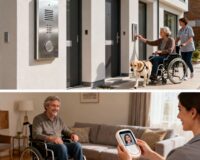In modern residential and commercial design, automation is no longer a luxury reserved for high-tech buildings — it has become a standard expectation. One of the most impactful technologies improving accessibility, safety, and daily convenience is the Automatic Swing Door Opener. These systems transform traditional hinged doors into smart, user-friendly access points that open and close automatically using sensors, motors, or wireless controls.
Whether you’re improving accessibility for elderly family members, installing hands-free doors in a busy commercial facility, or upgrading your business to meet today’s hygiene and efficiency standards, an automatic swing door opener offers unmatched benefits. This comprehensive guide dives into everything you need to know — how these systems work, their types, benefits, applications, installation considerations, safety compliance, costs, and tips for selecting the ideal opener for your needs.
What Is an Automatic Swing Door Opener?
An Automatic Swing Door Opener is a motorized device designed to automate the opening and closing of swing (hinged) doors. Using a combination of electromechanical components, sensors, and control units, these systems allow the door to move without manual effort.
They can be installed on new doors or retrofitted onto existing ones, making them suitable for:
-
Private homes
-
Disability-access living spaces
-
Small offices
-
Retail stores
-
Hospitality venues
-
Hospitals and healthcare facilities
-
Warehouses and industrial buildings
Automatic swing door openers help streamline movement, reduce physical effort, enhance hygiene by limiting touchpoints, and improve security when connected to access control systems.

How Automatic Swing Door Openers Work
Although the technology behind these systems varies, most automatic swing door openers operate using the same core components:
Motor and Gear Mechanism
At the center of every system is a motor — often electromechanical — connected to gears that provide the torque needed to swing the door open or closed. Modern motors are energy-efficient and designed for continuous or semi-continuous operation.
Control Unit (Microprocessor Board)
This acts as the “brain” of the door opener. It interprets signals from activation devices (buttons, sensors, remotes), manages safety responses, controls motor speed, and coordinates the timing of opening and closing cycles.
Activation Devices
These devices trigger the door’s operation. Common activation methods include:
-
Motion sensors
-
Push-to-open wall buttons
-
Wireless handheld remotes
-
Mobile app or smart home systems
-
Access card readers
-
Keypads
-
Touchless wave sensors
The activation method depends on the environment — for example, hospitals often use touchless wave sensors, while homes may use remotes or smartphone apps.
Safety Devices
Safety is critical, especially in commercial buildings. Features may include:
-
Obstacle detection sensors
-
Auto-reverse function
-
Adjustable closing force
-
Slow-start and slow-stop function
-
Emergency manual release
These features help prevent accidents, reduce door impact, and ensure smooth operation.
Power Supply & Backup
Most systems use standard AC power. High-end models include:
-
Battery backup units
-
Built-in UPS (Uninterruptible Power Supply)
This ensures operation during power outages — essential for commercial and healthcare settings.

Types of Automatic Swing Door Openers
Understanding the different types helps determine the most suitable model for your home or business.
Fully Automatic Swing Door Openers
These open and close automatically without manual effort using motion sensors or other activation devices. They are ideal for spaces with moderate to high foot traffic.
Best for:
-
Hospitals
-
Shopping malls
-
Hotel entrances
-
Commercial buildings
Low-Energy Automatic Swing Door Openers
These open more slowly and use less energy. They are activated by push buttons or remotes.
Best for:
-
Small offices
-
Schools
-
Assisted living facilities
-
Residential interiors
Electromechanical Operators
Powered entirely by electric motors and gears, these units are strong and durable. They are suitable for heavy or frequently used doors.
Advantages:
-
Long life cycle
-
Handles heavy doors
-
Excellent for public buildings
Electro-Hydraulic Operators
These use hydraulic pressure to control movement, offering smooth and near-silent operation.
Best for:
-
Luxury homes
-
Hotels
-
Boardrooms
-
Quiet environments
Smart Swing Door Openers
The newest generation integrates with smart home platforms:
-
Google Home
-
Apple HomeKit
-
Amazon Alexa
-
Mobile apps
-
Bluetooth and Wi-Fi systems
Benefits include:
-
Remote monitoring
-
Scheduled automatic locking
-
Activity tracking
-
Voice control
These are increasingly popular in modern homes and smart commercial buildings.

Benefits of Installing an Automatic Swing Door Opener
Enhanced Accessibility
Automatic swing doors are essential for people with mobility challenges, seniors, or those using wheelchairs, walkers, or crutches. A single button or wave sensor can open the door effortlessly.
Improved Hygiene (Touchless Entry)
These systems reduce the need to touch door handles — vital in:
-
Hospitals
-
Food processing areas
-
Clinics
-
Gyms
-
Commercial kitchens
Touchless operation lowers germ transmission and maintains a cleaner environment.
Increased Security
When integrated with access control:
-
Only authorized individuals can enter
-
Doors can auto-lock
-
Activity logs can be monitored
-
Entry can be controlled remotely
This makes automatic swing door openers a great choice for warehouses, offices, or secure areas.
Convenience and Smart Control
Homeowners enjoy:
-
Hands-free entry when carrying groceries
-
Remote door access for guests or deliveries
-
Voice-control convenience
Businesses benefit from automated traffic flow and reduced manual effort.
Energy Efficiency
Automatic doors help retain indoor temperatures by reducing unnecessary open time. This results in lower heating and cooling costs.
Smooth Traffic Flow
In high-traffic environments, automated timing allows safe, consistent door movement that prevents congestion.
Improved Building Compliance
Commercial properties often require accessible entrances under building codes.
In Australia, these must comply with the Disability (Access to Premises) Standards.

A Deeper Look at Automatic Swing Door Opener Technologies
While automatic swing door openers may appear simple from the outside, the internal technology is sophisticated and engineered for reliability, safety, and long-term performance. Modern systems blend mechanical strength with advanced electronics, often enhanced by smart automation.
Electromechanical vs. Electro-Hydraulic Systems
There are two main engineering approaches:
Electromechanical Operators (Most Common)
These are driven entirely by electric motors and gears. They offer:
-
High durability
-
Suitable for heavy and frequently used doors
-
Lower maintenance
-
Reliable performance in a wide range of environments
Electromechanical systems are ideal for:
-
Schools
-
Hospitals
-
Offices
-
Commercial buildings
-
Outdoor entrances
Because they can handle continuous use, they are often the go-to choice for high-traffic entryways.
Electro-Hydraulic Operators (Premium Models)
These combine electric control with hydraulic motion, providing:
-
Ultra-smooth operation
-
Minimal noise
-
Gentle door movement
-
Enhanced longevity when noise reduction is essential
They are typically used in:
-
Luxury hotels
-
Private residences
-
Executive offices
-
Quiet environments
-
Care facilities
Hydraulic systems are more expensive but deliver a premium feel that many residential clients seek for indoor automation.
Advanced Activation Technologies Explained
Today’s activation devices go far beyond simple push buttons. Different environments require different triggers for opening the door.
Motion Sensors
Widely used in commercial buildings, they automatically detect movement and open the door instantly. They’re ideal for:
-
Hospitals (for touchless entry)
-
Shopping centers
-
Offices
-
Airports
Motion sensors reduce physical contact and streamline traffic flow.
Touchless Wave Sensors
These allow users to wave their hand near a sensor plate. Since they do not require physical contact, they are excellent for:
-
Medical areas
-
Cleanrooms
-
Food processing facilities
-
High-hygiene environments
This type gained huge adoption after COVID-19 due to its hygiene benefits.
Push Buttons
Popular in accessible homes and small business areas, these require users to press a button to activate the door. They are:
-
Cost-effective
-
ADA- and accessibility-friendly
-
Easy to install
Buttons may be wired or wireless.
RFID Cards, Fobs & Access Control Systems
Used where security matters, such as:
-
Staff entrances
-
Warehouses
-
Restricted labs
-
Back-of-house business areas
These systems allow only authorized users to open doors.
Smart Home & Mobile App Control
Modern door openers increasingly integrate with:
-
Google Home
-
Amazon Alexa
-
Apple HomeKit
-
Proprietary phone apps
This enables homeowners to:
-
Open doors remotely
-
Check door status
-
Set schedules
-
Connect with security cameras
-
Receive alerts
The future of door openers is deeply integrated with smart home ecosystems.
Learn more about the latest automated door solutions for buildings and discover how they can enhance security and accessibility in your property — visit Digital Home Systems
Why Safety Is the Most Important Factor
Safety is non-negotiable when it comes to automatic swing doors. Commercial properties are legally required to follow safety codes, but even residential users benefit from advanced protection.
Obstacle Detection
If the system detects a person or object in the path, it automatically stops or reverses.
Anti-Pinch Technology
Prevents the door from closing with excessive force that could injure users.
Slow-Start and Slow-Stop
Reduces mechanical stress on the door and prevents sudden movement.
Manual Release for Emergencies
Allows manual door operation during emergencies, fire alarms, or power outages.
Fire Safety Integration
In commercial buildings, door openers may integrate with fire systems to:
-
Unlock automatically
-
Stay open during evacuation
In Australia, all commercial buildings must comply with accessibility and safety laws.
Installation Considerations — Expanded
Door Weight and Load Capacity
Door openers have maximum weight ratings. Installing a low-capacity opener on a heavy door can lead to:
-
Motor strain
-
Reduced lifespan
-
Safety hazards
Industrial steel or fire doors require heavy-duty operators.
Environmental Conditions
Indoor-rated models should never be installed outdoors unless properly protected. Weatherproof enclosures may be needed for:
-
External gates
-
Carport access
-
Loading bays
Humidity, dust, and temperature extremes all affect longevity.
Electrical & Wiring Requirements
Most automatic door openers require:
-
A dedicated electrical circuit
-
Proper grounding
-
Safe routing of cables
For mobile-app or Wi-Fi units, a strong local network connection is important.
Space for Arm and Mechanism Movement
Some older buildings have narrow frames or limited space around the door. Therefore, specialists may need to:
-
Install concealed units
-
Use custom brackets
-
Reposition sensors
-
Add reinforcement to weak frames
Mounting options include:
-
Surface-mounted arm operators
-
Concealed door frame systems
-
In-floor mechanisms (premium setups)
Compliance and Certification
Commercial properties must meet accessibility standards. Homes with elderly or disabled residents may benefit from systems certified for disability access.
Certifications may include:
-
ADA compliance (international standard)
-
Australian premises accessibility standards
-
Fire door compatibility certifications
Conclusion
An Automatic Swing Door Opener is one of the simplest yet most effective upgrades you can make to your home or business. It improves accessibility, boosts hygiene, enhances security, and provides unmatched convenience. With advancements in smart automation, these systems are becoming more affordable and easier to integrate with modern buildings.
Whether you’re installing it to assist elderly family members, improve customer flow in your business, or modernize your facility, choosing the right automatic swing door opener ensures years of reliable and safe operation. Consider your door type, usage level, and required features — and always ensure compliance with safety standards.
As technology continues to evolve, automatic swing doors will play a crucial role in creating smarter, safer, and more accessible environments for everyone.
Upgrade your home or business with advanced automatic door systems. Explore top solutions and smart automation at Digital Home Systems






